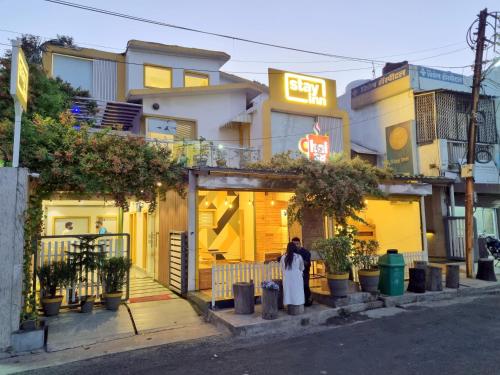Bhimbetka Rock Shelters, Madhya Pradesh, India
Did they mean to create an art gallery for us? A collection of work that goes back for millennia? A range of cave paintings that tells the story of history as well as any books could?
Because that’s what you find at the Bhimbetka Rock Shelters near Bhopal in India.
The Bhimbetka cave paintings are not just the artistic creations of one group of people. They are from many groups – stretching for more than 30,000 years!
Why did ancient humans keep coming back here to do the next generation’s paintings? Did they want to create this historical art museum for us? Or perhaps there was something special about Bhimbetka?
Whatever the reason, there’s no doubt that there’s something special about the Bhimbetka Rock Shelters today.
I arrive at the Bhimbetka caves from Bhopal, about an hour’s drive away. The landscape does little to build anticipation for what it hides – it’s just seems like trees on the approach.
But as you start to walk down the path from the entrance, you get the first taste of what lies ahead.
Enormous cliffs of sandstone rise up in front of me. They are textured, full of grooves and curves that give way to small caves and large shelters.
Erosion formed these shapes over millions of years. Humans have taken over the decoration of them for thousands.
On the walls and ceilings inside the Bhimbetka caves and rock shelters are clearly-distinguishable images that have been painted here. Human figures, animals, patterns.
Walking through tunnels formed by rocks falling onto each other, under rock shelters, and past small caves, I stop at each painted wall and look closely at the art.
There is a range of styles here. There are large simple representations of animals; general images showing humans doing things like hunting; more specific scenes about battles; and religious motifs like gods.
One of the reasons there is such a range is because these paintings were created on the rocks at Bhimbetka over such a long period.
The more simple patterns and focus on animals were from the Old Stone Age, about 30,000 years ago.
The paintings that show agricultural scenes, for instance, are from the Bronze Age.
And the images of tree gods and magic chariots are as recent as the Middle Ages.
But the other reason there is a range is because the humans who painted the Bhimbetka caves were interested in lots of different things.
They wanted to tell their own stories – about their battles and their industries. But they also wanted to record the world around them – with the animals they saw. And they also wanted to honour their gods.
In total, there are about 500 rock shelters at Bhimbetka, spread out over different hills that form a rocky range about 50 kilometres from Bhopal.
Although they have each been studied by experts, there are only 15 caves that are open to the public. That might sound like a small amount, but there is so much to see in each one, that it can still take an hour or two to walk through and look at each one properly.
One of the most physically-impressive caves is the Auditorium Cave. It’s the largest rock shelter at Bhimbetka and has the feel of a cathedral to its scale and shape.
We don’t know how the ancient people used this space but I can only imagine it was the setting for some of their important ceremonies.
One of the most artistically-impressive rock shelters is the Zoo Rock Shelter, where the ceiling is covered in images of animals.
In fact, there are 252 animals of 16 different species here. There are also about 90 human figures.
It’s a particularly interest collection of paintings because, amongst the animals, there is the depiction of a royal procession white horsemen and soldiers dressed with headgear and carrying weapons, while accompanied by two drummers.
I always find it incredible to see the creations of humans from thousands of years ago. The Bhimbetka Rock Shelters remind me of my visit to the Cave of Hands in Argentina, where there are also paintings from a time that seems impossible to imagine.
Although, if I think it’s hard to imagine what it was like to live on the subcontinent 30,000 years ago, there’s no way those people would be able to picture the world today.
At least they left us some clues. What you find at the Bhimbetka caves are the earliest traces of human life in this part of the world. And it really is quite a rare glimpse into how they spent their days and lived their lives.
Without the paintings here at Bhimbetka, our understanding of human history would be much poorer.
The Bhimbetka Rock Shelters World Heritage Site is not simply one of the largest prehistoric art complexes in the world, it is also a museum and a library. It is a portal to the past and an invaluable collection of stories from our ancestors.
You’ll probably need to use a tour or a driver to get to Bhimbetka. I would suggest looking at this option or perhaps this option.
THE BEST ACCOMMODATION IN BHOPAL
I have some suggestions for good accommodation in Bhopal here, which is the best base from which to explore the region.
BACKPACKER

If you’re looking for a good budget option, StayInn Hostel has private rooms.
BUDGET

A nice cheap option close to the main train station is FabExpress HTC.
BOUTIQUE
If you’re looking for a comfortable business-style hotel, The Courtyard by Marriott is the best in Bhopal.
LUXURY
And I think the nicest hotel in Bhopal, with some lovely history, is the Jehan Numa Palace Hotel.
This site helped me a hell lot! THNX!